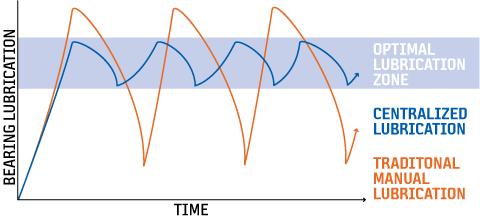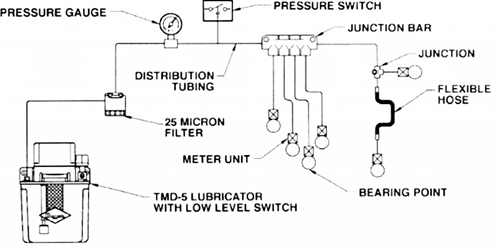Centralized Lubrication
Understanding Centralized Lubrication
Maintaining properly lubricated machinery is an important part of any lubrication program. Without administering lubricant at correct intervals with the proper amount, a machine can experience costly failures. Centralized lubrication systems are a common tool used in industry to distribute a precise amount of lubricant to specific locations at specific times through the use of programmable timers or integral timing motors, pumps and distribution elements.
Centralized lubrication systems were introduced in the mid-1930s. Since then, much research has concentrated on resolving the flow issues of viscous lubricants, such as grease, to deliver the fluid properly to its designated points. Advancements in technology have created today’s centralized lubrication systems with precise delivery methods for a wide range of industrial applications. Centralized lubrication systems are sometimes referred to as automatic lubrication systems because they are completely or mostly computerized in the process of lubricant dispensing.
These systems eliminate the risk of human error and increase precision when an application requires the lubrication of many components on numerous machines. Centralized lubrication can deliver either grease or oil to a lubrication point. The basic operation of a centralized system includes the following components:
- PUMP – manual, air or motor driven
- DISTRIBUTION ELEMENTS – Meter Units, Injectors or Progressive Blocks.
- DISTRIBUTION NETWORK – hose & tubing plus various junctions and connectors.
- MONITORING DEVICES – pressure gauge, low oil level switch, pressure switch, controller/ timer
The system controller and distribution elements are preset to deliver a specific amount of lubricant at a specific interval. To deliver the lubricant, the pump is activated by the motor or an air solenoid valve. This builds pressure in the lines, causing the lubricant to flow out to the bearing surfaces of all types, including plain bearings, antifriction bearings, gears, chains and way surfaces.
Technological advancements have created many products for controlling and monitoring centralized lubrication systems that further increase the precision and reliability of these systems. Lubricant, distribution elements, system plumbing and lubricant reservoirs are commonly monitored by alarms. An alert signal is sent when an undesirable flow pattern exists or when the lubricant reservoir is low. Incorporating such alarms into a system is useful in preventive maintenance. Furthermore, to prolong maintenance intervals, high-capacity lubricant reservoirs can be incorporated into the systems and they typically hold double the volume of the common system reservoir.
Traditional manual lubrication methods have a tendency to either under or over lubricate the bearing surfaces. This is a proven cause of most bearing failures. A properly designed system consistently wets the bearing surfaces with a fresh supply of lubricant in the precise amounts at specific times in the correct locations. In addition, frequently delivering smaller amounts of lubricant while the equipment is running keeps your machine in the “Optimum Lubrication Zone”.

Please contact Fluidline System’s experienced team of application engineers. They can help you determine which system is best for your application.
Machines and Industries requiring Lubrication Systems
Machines Requiring
Lubrication Systems
|
Industries Requiring
Lubrication Systems
|
|
Metal Lathes
|
Agriculture
|
Mobile On-road
|
|
Surface Grinders
|
Automotive
|
Packaging
|
|
Machining Centers
|
Cement
|
Printing
|
|
Saws
|
Food & Beverage
|
Pulp and Paper
|
|
Drills
|
Machine Tools
|
Railway
|
|
Milling Machines
|
Mining
|
Steel
|
|
Presses
|
Mobile Off-road
|
Wind Energy
|
|

